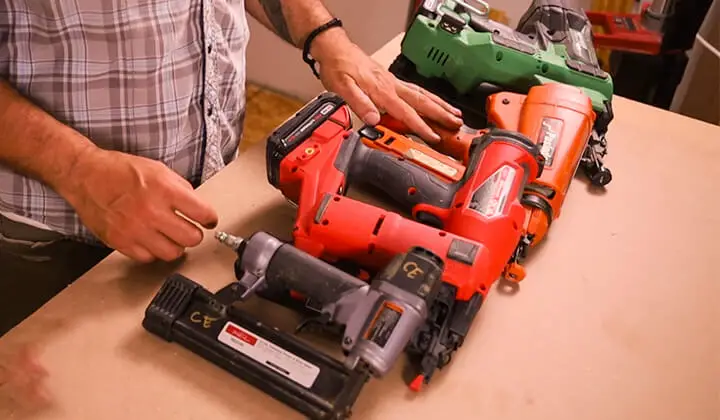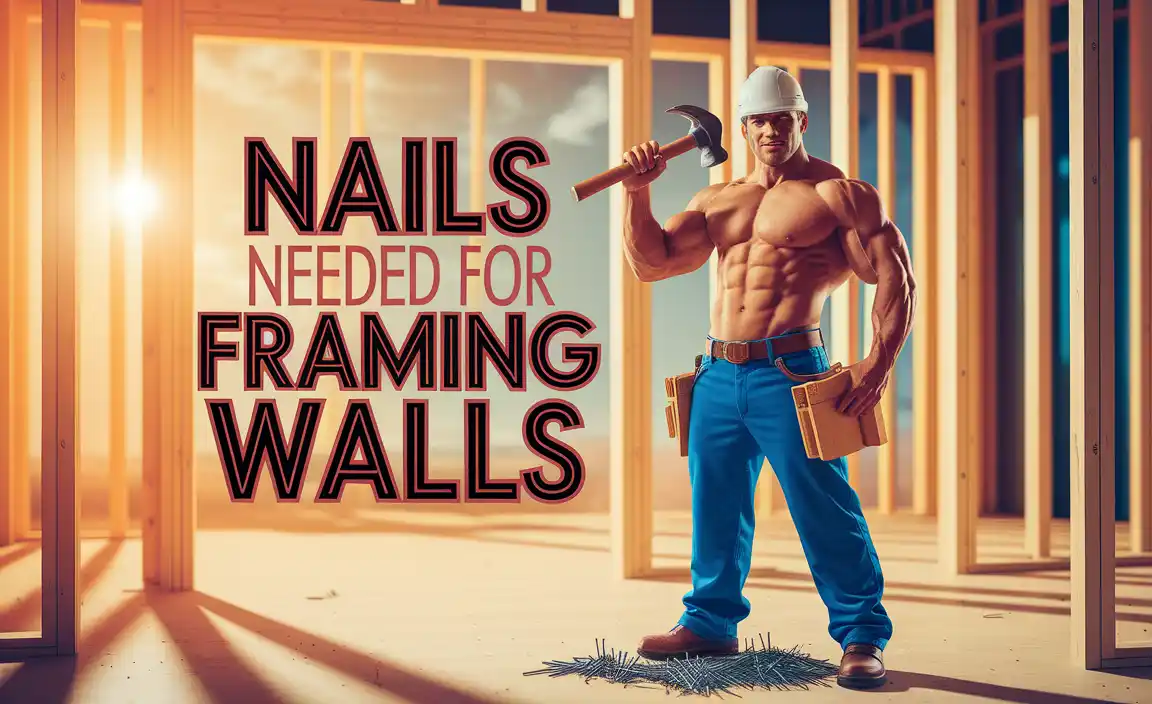Quick Summary: Yes, you can fix bent nail gun magazine rails! With patience and the right tools, you can gently straighten bent rails to ensure your nailer feeds nails smoothly again, saving you money and frustration.
Hey there, fellow woodworkers and DIY enthusiasts! Jack Shaffer here, your go-to guy for all things nail guns and woodworking. Ever been in the middle of a project, ready to fire off a perfect nail, only to have your nail gun jam? More often than not, a bent nail gun rail is the culprit. It’s a common, super frustrating problem, but don’t worry! It’s usually quite fixable, and I’m here to walk you through exactly how to do it. We’ll get that nailer feeding like new again, so you can get back to creating!
Table of Contents
Why Your Nail Gun Rails Get Bent
Nail gun rails, also known as the magazine or track, are the guides that hold your nails in perfect alignment. They’re designed to be sturdy, but they’re not invincible. Several things can cause these crucial parts to bend:
- Accidental Drops: This is probably the most common reason. If your nail gun takes a tumble onto a hard surface, a corner or edge of the magazine can easily dent or bend. Even a fall from a few feet can do it.
- Impacts During Use: Sometimes, while working, the nailer might get bumped against a workbench, a stud, or another object. This impact can put pressure on the rails and cause them to warp.
- Forcing Nails: While rare, trying to shove oversized or misaligned nails into the magazine forcefully can put stress on the rails and potentially bend them over time.
- Storage Issues: Improper storage, where the nail gun is stored without protection and something heavy is placed on top of it, can also lead to bent rails.
- Manufacturing Defects: Though uncommon, a slight imperfection from the factory could make a rail more susceptible to bending under normal use.
It’s important to understand that these rails are usually made of aluminum or a strong polymer. While these materials are chosen for their lightweight and durability, they can still be deformed under stress. Recognizing the cause can help you be more mindful in the future!
Signs of Bent Nail Gun Rails
Before you can fix bent rails, you need to be sure that’s the problem. Here are the tell-tale signs:
- Nail Jams: This is the most obvious symptom. Nails won’t feed properly, leading to frequent jams. You might find nails getting stuck at an angle or failing to advance in the magazine.
- Difficulty Loading Nails: When you try to load a strip of nails, they might snag or resist going all the way in. They might not sit flush at the bottom of the magazine.
- Nails Firing Crooked: Even if a nail does fire, it might go in at an angle. This happens when the bent rail isn’t guiding it straight towards the nose of the nailer.
- Visible Damage: Inspect the magazine closely. Look for any dents, creases, or out-of-line sections on the rails where the nails slide. You might see scratch marks inside the rail that indicate nails are catching.
- Inconsistent Firing: The nail gun might fire erratically or not consistently drive nails to the correct depth.
If you’re experiencing any of these issues, especially after a drop or bump, it’s highly likely your nail gun rails are the cause. Don’t panic; these problems are often reversible!
Tools You’ll Need to Fix Bent Nail Gun Rails
Gathering the right tools before you start will make the process smoother and safer. You don’t need a whole workshop for this, but a few specific items will make all the difference. Here’s what I recommend:
- Safety Glasses: Absolutely crucial! You’ll be working with metal and potentially sharp edges. Protect your eyes.
- Gloves: To protect your hands from sharp edges and prevent grease or dirt contamination on the nailer’s parts.
- Pliers:
- Needle-nose pliers: Good for small adjustments and gripping.
- Flat-jawed pliers: Excellent for applying even pressure without marring the metal.
- Rubber Mallet or Wooden Block: For gently tapping and persuading bent areas back into place. A rubber mallet is ideal as it applies force without damaging the metal surface.
- Small Hammer: For more delicate tapping if needed.
- Soft Cloths or Rags: To clean the magazine and protect surfaces.
- Penetrating Oil (Optional): A tiny amount can help loosen stubborn parts or reduce friction, but use it sparingly.
- Straight Edge or Ruler: To check for straightness and flatness once you’re done.
- Non-Marring C-Clamp or Vise Jaws (Optional): If you have these, they can be very helpful for holding parts steady.
- Work Surface: A stable, flat workbench or sturdy table. It’s ideal if you can cover it with a soft cloth to protect the nail gun.
Having these tools ready will set you up for success. Remember, the key here is patience and gentle application of force. We’re trying to persuade the metal, not overpower it.
Step-by-Step Guide: How to Fix Bent Nail Gun Rails
Alright, let’s get down to business! This guide will take you through the process of straightening those bent nail gun rails. Remember to work slowly and methodically.
Step 1: Disconnect Power and Safety Check
This is the absolute first and most important step. Your safety is paramount.
- Unplug the nailer: If it’s an electric or cordless nailer, remove the battery.
- Remove Air Hose: If it’s a pneumatic (air) nailer, disconnect the air hose.
- Remove All Nails: Empty the magazine completely of any nails. Double-check that no nails are lodged inside.
Never attempt any repair or adjustment while the nailer is powered or connected to an air source. This prevents accidental firing.
Step 2: Inspect the Magazine Thoroughly
Get up close and personal with your nail gun’s magazine. Gently run your fingers along the inside and outside of the rails. Feel for any bumps, dents, or sections that don’t feel smooth.
- Use a flashlight to illuminate the area.
- Look for any visible bends, kinks, or flat spots.
- Check if the rails are parallel to each other and aligned with the main body of the nailer.
- Pay close attention to the front and rear of the magazine, as these areas often take the brunt of an impact.
Identifying the exact location and severity of the bend is crucial before you start any straightening. Sometimes, it’s just one small dent; other times, it might be a more gradual curve.
Step 3: Gently Straighten Minor Bends
For small dents or slight misalignments, you might be able to use your hands and some gentle leverage.
- Apply gentle pressure: With your gloved hands, try to gently push or pull the bent section back into alignment.
- Use flat-jawed pliers: If you can access the bent area with flat-jawed pliers, grip the rail firmly but not so hard that you’ll create new damage.
- Work the bend: Gently rock the bent section back and forth, applying slight pressure in the opposite direction to the bend.
- Use a rubber mallet: For slight outward dents, you can sometimes place a soft cloth over the dent and gently tap with a rubber mallet. Work from the edges of the dent towards the center.
The goal here is to coax the metal back into shape. Avoid sudden, forceful movements. Small, repeated adjustments are better than one big, potentially damaging attempt.
Step 4: Address More Significant Bends
If the bend is more pronounced, you’ll need a bit more assistance from your tools.
- Secure the Nailer (Optional but Recommended): If possible, gently clamp the main body of the nailer to your workbench, ensuring the magazine is accessible and not stressed. Use soft jaws or cloth to protect the tool.
- Using Flat Pliers and a Block: For a straight, out-of-line bend, you might place a flat block of wood against the rail and use your flat-jawed pliers to grip the rail on the opposing side.
- Apply Leveraged Force: Use the wood block as a pivot or fulcrum. Gently apply steady pressure with your pliers, using the block to guide the straightening process.
- Tapping with a Mallet: If the metal is slightly creased, you can place a flat piece of metal or a strong, smooth block of wood against the bend (on top of a cloth) and gently tap it with a rubber mallet. Work the mallet taps around the bend, gradually reducing the imperfection.
- Working from the Outside In: Always try to work on the bend from the edges inwards, little by little.
This stage requires patience. It might take several attempts to get the rail straighter. Always check your progress frequently.
Step 5: Check for Straightness and Smoothness
Once you believe you’ve made progress, it’s time to test your work.
- Visual Inspection: Hold the nailer up and look down the length of the magazine rails from both ends. Use a straight edge or ruler held alongside the rails to check for any deviations.
- Feel Test: Gently slide a finger (carefully, with gloves!) along the inside of the rails. It should feel smooth, with no catches or snags.
- Test Feed: Carefully try to slide a strip of nails down the magazine manually. They should move freely and without resistance from one end to the other.
If you still feel catches or see significant bows, you might need to repeat steps 3 and 4, possibly in slightly different areas. Don’t over-work the metal; you don’t want to weaken it.
Step 6: Reassemble and Test Fire
If your inspection shows the rails are straight and smooth, it’s time to put it all back together and test it out.
- Load Nails: Load a strip of the correct type and size of nails into the repaired magazine.
- Check Loading: Ensure the nails slide in easily and sit flush and straight.
- Reconnect Power: Reattach the battery or air hose.
- Safety First: Point the nailer in a safe direction (away from yourself and others, into a piece of scrap wood).
- Test Fire: Squeeze the trigger. The nail should fire smoothly and drive into the wood without issue.
- Fire a Few More: Fire several more nails from different positions in the magazine until it’s empty. Listen for any catches and watch how the nails are driven.
If the nailer fires consistently and the nails go in straight, congratulations! You’ve successfully fixed your bent nail gun rails.
When to Consider Professional Repair or Replacement
While many bent rail issues are fixable with a DIY approach, there are times when it’s best to call in the pros or consider replacing the part.
When DIY Might Not Be Enough:
- Severely Damaged Rails: If the rails are severely kinked, cracked, or significantly torn, attempting to bend them back might only cause further damage.
- Multiple Bends: If there are numerous bends along the entire length of the magazine, it can be very difficult to get them all perfectly straight.
- Delicate Nailer Models: Some high-end or specialized nail guns have more intricate magazine designs. Forcing these could be risky.
- Lack of Confidence: If you’re not comfortable with the repair process or worried about causing more harm, it’s always okay to seek expert help.
When to Seek Professional Help:
- Manufacturer Service Center: Contact the manufacturer of your nail gun. They can advise if the magazine is a replaceable part and may offer repair services.
- Tool Repair Shops: Local power tool repair shops are often equipped to handle these kinds of repairs. They have specialized tools and experience.
When Replacement is the Best Option:
In many cases, nail gun magazines are designed to be replaceable parts, especially on pneumatic models. If your nailer is:
- Still Under Warranty: Check your warranty. Accidental damage might not be covered, but it’s worth checking.
- Older or Less Expensive: For older or more budget-friendly nailers, the cost of professional repair might approach the cost of a replacement magazine or even a new tool.
- Constantly Jamming: If repair attempts don’t fully resolve the issue, or if the problem recurs frequently, a new magazine is often the most reliable solution.
Replacement might seem like a last resort, but it ensures your tool functions reliably and safely, which is always the goal.
Maintaining Your Nail Gun to Prevent Future Issues
Once you’ve fixed your nailer, or if you’re looking to keep a new one in tip-top shape, a little preventative maintenance goes a long way. Following these tips can help prevent bent rails and other common nail gun problems:
- Handle with Care: Treat your nail gun like the precise tool it is. Avoid dropping it. When carrying it, use the handle or a dedicated tool bag.
- Store Properly: Store your nail gun in a safe place where it won’t be knocked around or have heavy objects placed on it. A padded tool bag or a dedicated toolbox is ideal.
- Use the Right Nails: Always use the nail size and type recommended by the manufacturer. Forcing incorrect nails can damage the magazine and feeding mechanism. Refer to resources like this Nail Gun Depot nail guide for proper sizing.
- Keep it Clean: Regularly clean the magazine and surrounding areas. Dust and debris can cause nails to snag, and repeatedly forcing nails past them can stress the rails. A quick wipe-down after use is beneficial.
- Gentle Loading: When loading nails, ensure they are seated correctly and don’t force them. If a strip doesn’t load easily, check for debris or a bent nail.
- Regular Lubrication (Pneumatic): For pneumatic nailers, a few drops of specialized air tool oil in the air inlet before each use (as per manufacturer instructions) can keep the internal mechanisms, including the feeding components, running smoothly.
- Inspect Before Use: Before starting a project, take a moment to quickly inspect your nail gun. Look for any obvious signs of damage or wear, especially on the magazine.
By adopting these simple habits, you’ll significantly extend the life of your nail gun and ensure it performs reliably for years to come. It’s all about treating your tools with the respect they deserve!
Frequently Asked Questions (FAQ)
Q1: Can I use a regular hammer and nails to fix bent nail gun rails?
A1: No, it’s not recommended. While you might use a small hammer and block, a regular hammer is too heavy and forceful. You need delicate tools like pliers and rubber mallets to make precise adjustments without causing more damage.
Q2: How do I know if the bend is too severe to fix?
A2: If the rails are severely kinked, creased, cracked, or if multiple bends exist along the length, the bend is likely too severe for a DIY fix. If you can’t get nails to feed smoothly after attempting the repair, it might be beyond repair.
Q3: Will straightening the rails affect the nailer’s performance?
A3: If done carefully, no. The goal is to restore the original alignment. If done improperly, you might create new issues. However, a successful repair will restore smooth feeding and prevent jams, improving performance.
Q4: What if I don’t have flat-jawed pliers? Can I use regular pliers?
A4: Regular pliers can work in a pinch, but use them with extreme caution. Wrap the jaws in a cloth or tape to prevent marring the aluminum or plastic. Flat-jawed pliers provide more even pressure and are less likely to cause damage.
Q5: My nail gun is still jamming after I tried to fix the rails. What now?
A5: It’s possible the bend wasn’t fully corrected, or there might be another issue causing the jams. Re-inspect the rails closely. If you can’t find any more bends, consider if there’s debris stuck in the magazine, or if the



